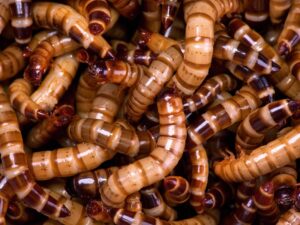 Silage making is in full throe across much of the country, but following a difficult winter and spring farmers need to take care to maximise quality and quantity this year. And they picked up plenty of top tips at Grassland UK on Thursday (10 May), with a tremendous demonstration of new kit and a plethora of advice on offer.
Silage making is in full throe across much of the country, but following a difficult winter and spring farmers need to take care to maximise quality and quantity this year. And they picked up plenty of top tips at Grassland UK on Thursday (10 May), with a tremendous demonstration of new kit and a plethora of advice on offer.
After the wet winter and spring, many farmers need to remedy problems with their soil to maximise grassland productivity, according to Calcifert consultant Mark Tripney, who was speaking in the British Grassland Society seminars. “Poor root development limits a lot of crops, so dig a hole. Do you feel the spade resisting and at what depth? Are their worms? The spade is a great tool for saving money and for targeting nutrients and machinery use.”
There was plenty of equipment on display at the event, offering farmers a wide choice for relieving soil compaction, from subsoilers to aerators. “I think aeration is a great tool which is under-utilised,” said Mr Tripney. It removes the thatch of grass on the soil surface, which prevents nutrients from getting down into the soil profile, and opens up compaction, enabling roots to grow down to find those nutrients.
While many farmers make great use of manure to reduce fertiliser applications, one concern – particularly on dairy farms – is the high level of potassium in the soil from repeated slurry applications. This locks up magnesium, causing problems both for the grass and the cattle. “Beware of the antagonisms which might be on your farm,” warned Mr Tripney. And test the soil for more than N, P and K. “Around 60% of grassland is short of calcium, which is essential for the structure of the soil and for cell development in the plant.”
Supplying sufficient nutrients for the crop is, of course, essential, and it’s vital to get on with aftercut fertiliser as soon as possible after taking the first cut of silage, said Graham Ragg, senior agronomist at Mole Valley Farmers. “You lose 2% a day in second cut yields for every day you delay putting on fertiliser after taking first cut,” he explained. “So if you wait a week you lose 14% or about 1t/acre.”
According to a survey by Germinal, over 40% of dairy farmers had shortened their cutting intervals over the past three years, with 92% reporting better silage quality as a result. However, it’s vital to choose the right grass mixtures, and the new Recommended Grass and Clover List, launched at Grassland UK, featured a number of new varieties, including AberBann and AberSwan from the IBERS breeding programme.
Oliver Seeds also launched a new multi-species grass mixture at the event, to meet increasing demand from farmers for species-rich herbal leys. “Multi-species swards have a lot of advantages over straight ryegrass leys,” said general manager Rod Bonshor. These include enhanced stress tolerance and persistence, with greater root mass and depth, and extended growth at both ends of the season. “The forage also has greater palatability, a higher trace element and mineral content, and some plants have anthelmintic properties which helps combat any worming problems.”
For those interested in the physical aspects of silage making there was lots of kit to choose from, from Fendt’s Katana forage harvester to John Deere’s new V400 variable chamber round balers. With more than 180 exhibitors across the 100-acre site, working machinery demonstrations included SIP’s Air Swath 300F, which made its UK working debut and is designed to produce top quality silage, free from soil and stones.
OPICO had the new HE-VA Grass Rejuvenator, designed to over-seed and reseed leys, while in the muck demonstration area Vredo Dodewaard demonstrated its self-propelled VT4556 TEBBE spreader and VT7028-2 liquid slurry machine.
Massey Ferguson enjoyed significant interest in a variety of new equipment – and William Judge, head of UK and Ireland noted an upbeat feel among dairy farmers. “People are investing in kit now while the milk price is good,” he said. “Ahead of Brexit, they are using this opportunity to invest while they know they still have the budget to do so.”
However, LIC’s Piers Badnell – who wrapped up the event in the final seminar of the day – warned farmers to create a lean, efficient business to survive post Brexit. “Volatility is here to stay and every business needs to make a profit under all eventualities,” he said. The UK has a climate suitable for grass growth, so farmers should be making more use of that to cut input costs.
On average, UK dairy farmers use just under 50% grass in the diet – but for every 10% point increase above this, farmers will save 4p/litre in costs of production, he added. But while it’s important to reduce external costs like concentrates and fuel, it’s vital to view labour as an investment.
“Good staff and attention to detail are the keys to every efficient business,” said Alan Lyons, head of shows at the Royal Bath & West Society. “But it’s also vital for those staff to keep up-to-date with the latest advice, technology and ideas. There was plenty of each on offer at Grassland UK and we were delighted to see so many people turn out at what is always a busy farming time of year.”
- For more information and to book tickets head to bathandwest.com.




